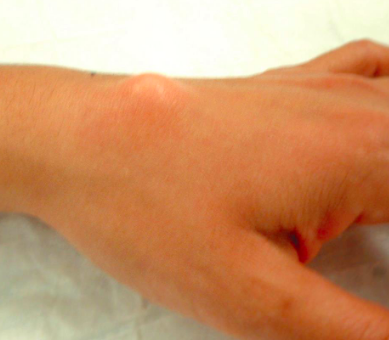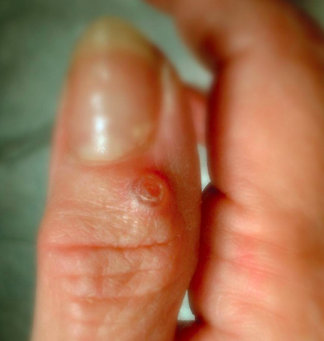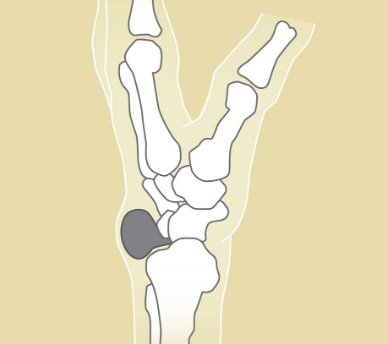Ganglion Cysts
Ganglion cysts are lumps around the hand and wrist that occur adjacent to joints or tendons. Ganglion cysts are very common. They are most frequently found on back of the wrist (see Figure 1), the palm side of the wrist, the base of the finger on the palm side, and the top of the end joint of the finger (see Figure 2). Ganglion cysts are filled with a clear, gel-like fluid and often resemble a water balloon on a stalk (see Figure 3). These cysts may fluctuate in size, and some may eventually disappear completely. Ganglion cysts are not cancerous and will not spread to other areas.



Causes
Ganglion cysts occur in patients of all ages. While their cause is unknown, they may form in the presence of joint or tendon irritation, arthritis, mechanical changes, or injury.
Signs and Symptoms
Ganglion cysts may or may not be painful. They are typically oval or round and may be soft or very firm. Cysts at the base of the finger on the palm side are typically very firm, smaller than a pea-sized nodule, and are tender to applied pressure, such as when gripping.
Cysts at the far joint of the finger frequently have arthritis associated with them. At this end knuckle, the overlaying skin may become thin, and there may be a lengthwise groove in the fingernail just beyond the cyst.
Diagnosing a Ganglion Cyst
The diagnosis is usually based on the location of the lump and its appearance. Light will often pass through these lumps, and this may assist in the diagnosis. Your physician may request x-rays in order to look for evidence of problems in adjacent joints.
Treatment
Treatment can often be non-surgical. In many cases, these cysts can simply be observed, especially if they are painless. Ganglion cysts frequently disappear spontaneously. If the cyst becomes painful, limits activity, or is otherwise unacceptable, several treatment options are available, including:
- Splints and anti-inflammatory medication to decrease pain associated with activities
- Aspiration to remove the fluid from the cyst and decompress it (This requires placing a needle into the cyst, which can be performed in most office settings. Aspiration is a very simple procedure, but recurrence of the cyst is common.)
If non-surgical options fail to provide relief, or if the cyst reoccurs, surgical alternatives are available. Surgery involves removing the cyst and may include removal of a portion of the joint capsule or tendon sheath. In the case of wrist ganglion cysts, both traditional open and arthroscopic techniques usually yield good results. Surgical treatment is generally successful, although cysts may reoccur. Your hand surgeon will discuss the best treatment options for you.
